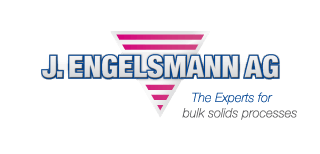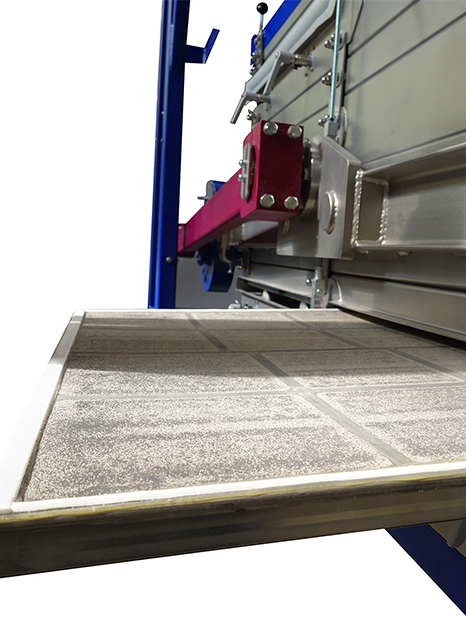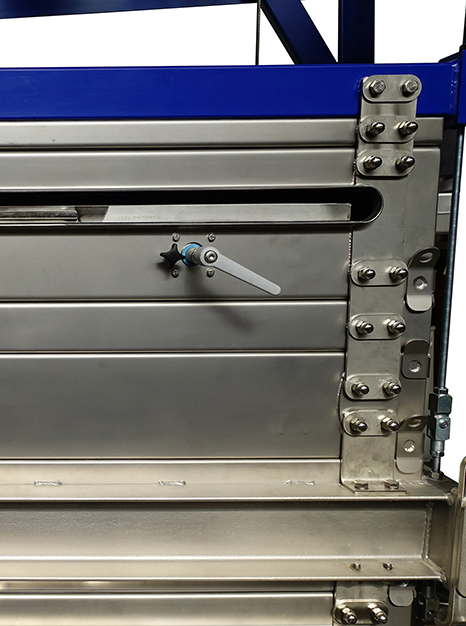02.05.2017
Well-prepared for all screening tasks:
Engelsmann Freischwinger series is completed by new screening machine JEL Phoenix
With JEL Phoenix, J. Engelsmann AG developed a new dedicated screening machine for applications in the chemical industry. As a new version of the tried-and-tested Freischwinger series, it combines the particularly gentle long-stroke screening procedure with a great deal of versatility. The core element of the machine is a free-swinging modular sieve cassette system which opens up numerous combination possibilities for the operator to retrofit the screening machine for different tasks (protective, oversized particles, fine and classification screening) or materials. The functional principle is pretty simple: Up to four sieving cassettes can be stacked upon one another, e.g. to increase the screening surface and/or the throughput of the sieve or the number of fractions to be separated. By using different sieve mesh widths, conventional combined screening procedures such as coarse and fine screening with JEL Phoenix can also be emulated.
The screening machine is constructed in a modular way and basically consists of a stable base frame and the sieve cassette module which is suspended in the frame using steel ropes. A special oscillating drive provides for a horizontal swinging movement. The product is fed into the JEL Phoenix via an inlet in the upper area. According to the task, the product flow is either distributed to different screen decks with the same mesh width and thus over an increased screening surface (e.g. increasing the throughput when screening coarse material) or it gradually passes single sieve inserts with different mesh widths when coming from above (as with classification screening with several fractions). The grain size sievable by the JEL Phoenix ranges from 40 µm to 20 mm and the screening surface can be extended from 1.5 up to 6 m². The screening machine is manufactured in stainless steel as a standard (parts coming into contact with the product) and can be individually adapted to the requirements of the operator. For applications with primary products of foodstuff or usage in explosive environments, JEL Phoenix is also available with FDA-compliant seals or as ATEX version.
JEL Phoenix for sifting off oversized and undersized particles with catalysts
In order to minimize product damage, it is absolutely critical for manufacturers of sensitive products that the production procedures are as gentle as possible – this shall apply for the used screening technology as well. Since catalysts are very fragile, catalyst manufacturers are particularly depending on gentle screening procedures in production. The manufacturer in this example has been utilizing a vibration screening machine to remove oversized and undersized particles from the catalyst directly after the reaction process. Due to the strong vibration of the fabric, the granular product “bounces” up and down on the entire screening surface which leads to a partial breaking of the sensitive catalysts. This is how a just perfect grain size turns into an undersized grain. Another problem are oblong catalysts which take a vertical position due to the screen excitation and clog up the screen fabric.
To tackle this problem, the operator decided to convert to a long-stroke screening procedure. Thanks to its uniform and horizontal swinging motion, this procedure is perfectly suited for fragile products. Since the swinging motion occurs only on a horizontal plane, the product remains on the screening surface which prevents the formation of clogging material and achieves a particularly high separation precision. The oscillating drive of the JEL Phoenix is extremely energy-efficient, since – after just 15 seconds – the oscillating weight is kept in motion with only 10-20 percent of the nominal current.
To feed the product into the screening machine, a special cascade feeding has been used in this case, in order that the catalysts are conveyed onto the screen fabric in a safe manner. The abrasiveness of the catalysts causes a relatively fast wear and frequent replacement of the used screen fabrics. For the operator, frequent replacements of the sieve insert often involve a considerable time and cost effort, especially because the system is at standstill during replacement. And here as well, the JEL Phoenix convinces with its functionality: the inserts can be laterally removed from the cassette with only little effort and without tools, so that the screen change takes not more than 30 seconds. The insertion slots on the cassettes are sealed with a specially designed rubber cover which can be easily removed and remounted when changing the sieve inserts.
The outlet connection pieces of the single sieve decks are positioned on the front end on the opposite side of the oscillating drive and can be arranged in a flexible manner. In this way, the JEL Phoenix can be optimally adjusted to the installation situation in the system of the operator – perfect for application cases where the conveyor line between inlet and outlet area needs to be bridged.
By using the JEL Phoenix, the catalyst manufacturer could significantly reduce the amount of undersized grain and thus waste. The frequent sieve changes are now much more comfortable for the operator and also the maintenance efforts could be distinctly reduced when compared with the previous vibration screening machine.
JEL Phoenix for varying tasks in the production of detergents
This example from the detergent production shows the use of JEL Phoenix as a combined protection and classification screen.
Like many other industrially manufactured consumer goods, there is a constant development of new recipes also in the range of detergents, in order to provide customers with added value: e.g. fresh odor, color stability or environmental compatibility. Since these recipe changes generally affect the respective product specifications as well, this places specific requirements on the applied production equipment, such as screening machines.
A manufacturer of dishwasher tablets faced exactly this challenge and was seeking a screening machine which is, on the one hand, capable to remove agglomerates and/or oversized particles from the washing powder before it is fed into the tablet press. On the other hand, the production of some tablets required a classification screening of the product mixture in 3 fractions.
Due to changing recipes, it was important for the operator to use a screening machine which offered sufficient flexibility to adapt the screening procedures to the respective product characteristics, in order to always achieve a perfect result, independent of the recipe.
The first problem when sifting off oversized particles were the different flow properties of the detergent versions to be sieved. While one recipe distributed quickly and easily on the screening surface, for the second – with worse flow properties – the dumping angle had to be increased. With the JEL Phoenix, this can be regulated via the integrated stroke and sieve angle setting. The inclination of the sieving cassettes which are stacked on one another can be adjusted via a simple winding mechanism and by means of steel ropes. The stroke setting mechanism is positioned directly on the oscillating drive. Both – stroke and angle setting – are continuously adjustable and have a display scale so that the individual machine settings can be reproduced quickly.
When changing the recipe, the operator can convert the JEL Phoenix into a classification screen with minimum effort. Here, only the suitable sieving cassettes need to be mounted, which are designed with different mesh widths according to the desired range of grain sizes. Also in this respect, JEL Phoenix convinced with the highest separation precision between the single fractions and an excellent throughput, even though also the detergent recipe to be classified had bad flow properties. This has been optimized as well by means of the screen angle regulation.
The screen inserts of the protection as well as the classification version of the JEL Phoenix have been equipped with a ball-bearing cleaning system to remove the clogging material from the screen fabric. The ball bottoms are positioned directly underneath the insert in the sieve cassette and can – just like the inserts – be pulled out as required through the insertion slots of the cassettes. The adaption of an ultrasound system for especially fine mesh widths and products will be available by the end of this year.
Both case examples demonstrate the development concept behind the new screening machine in an impressive manner: With the Freischwinger version JEL Phoenix, the Engelsmann engineers developed a long-stroke screening machine with which operators can increase the throughput by stacking additional sieve decks or even retrofit the machine for other screening tasks (e.g. classification). To determine the optimum screen configuration, the technical department of Engelsmann AG in Ludwigshafen is at your disposal at any time.
Engelsmann AG will introduce its new long-stroke machine just in time for the SCHÜTTGUT trade fair in Dortmund on May 10 and 11, 2017.










